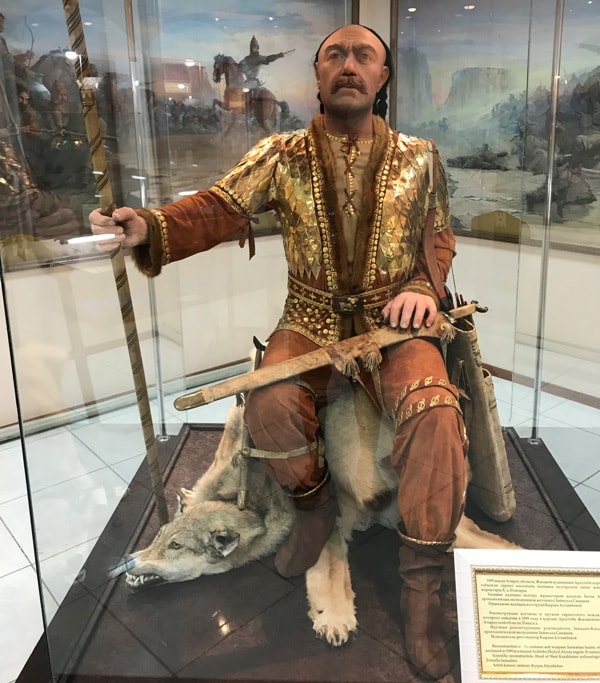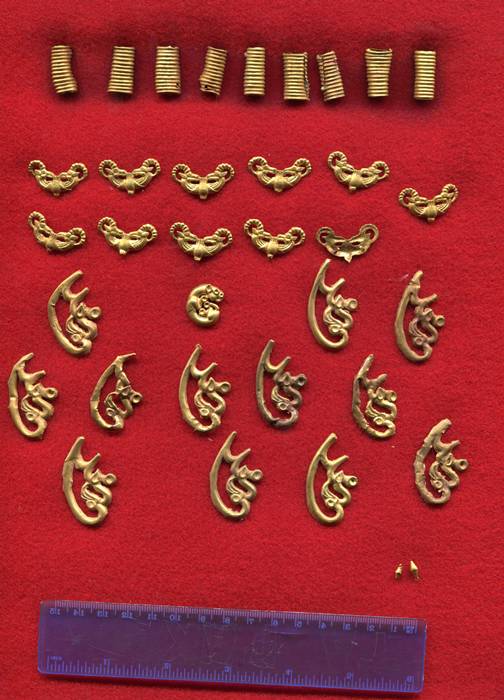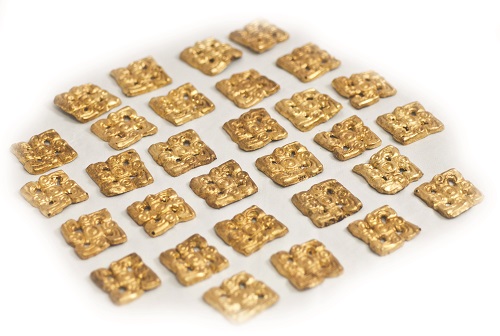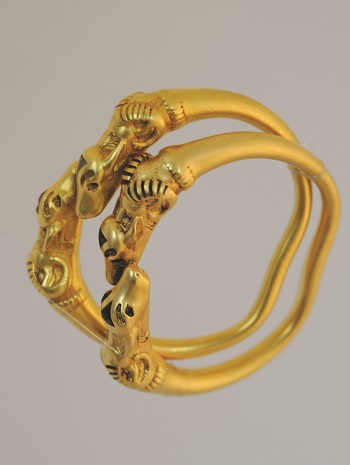2018年11月14日のカザフスタンの記事です。6つの発見は6か所の古墳という意味でしょうか。動物モチーフのブレスレットがスキタイっぽいです。そして、細かい黄金の飾りは、日本の古墳でも出土しています。
6 of Kazakhstan's largest archaeological finds in the last 50 years

10月上旬パブロダル地方では、イルティシュの海岸に釣り竿を持って座ることを計画していた漁師が、考古学的発見をしました。彼は、砂の層の下で粘土の壺を見つけました。専門家によると、この遺物は青銅器時代のアンドロニア文化に属しています。しかし、偶然の発見はむしろ例外です。通常は専門家を送ったり、宝物を求めて現代の金掘り、ディスカバリーチャンネルプロジェクト「ゴールドラッシュ」の英雄として、または歴史家、考古学者は、貴重な砂の穀物だけでなく、すべての黄金の埋葬物を見つけるためにうまく対処します。
Illustrative photo of alamy.es
In early October, in the Pavlodar region, a fisherman who planned to sit with a fishing rod on the shore of Irtysh, instead made an archaeological discovery: under a layer of sand he found a clay pot. According to experts, this relic belongs to the Andronian culture of the Bronze Age. However, random finds, rather, an exception - usually in search of treasure purposefully sent professionals: modern gold diggers, as the heroes of the Discovery Channel project "Gold Rush", or historians-archaeologists, who manage to find not just grains of precious sand, and whole golden burials.
イシク古墳 Mound Issyk
1969年、カザフスタン国立考古学学校の創設者の一人であるケマル・アキシェフ率いる探検隊がイシク古墳を発掘し始めたとき、誰もすぐに彼らがセンセーショナルな歴史的発見をするとは想像できませんでした。アルマトイから50キロに位置する古墳は、45の建物がある大規模な複合施設の一部でしたが、残りの部分から目立つものではありませんでした。それはわずか6メートルの高さで、スケールで15メートルの隣人に顕著に負けていました。さらに、他の多くの埋葬と同様に、イシクは数世紀前に略奪されたので、壮大な発見は数えるほどありませんでした。
When in 1969 an expedition led by Kemal Akishev, one of the founders of the Kazakh National Archaeological School, began to excavate the Mound Issyk, no one could have imagined that soon they would make a sensational historical find. The mound, located 50 kilometers from Almaty, was part of a large-scale mound complex of 45 buildings, but did not stand out from the rest - it was only six meters high and noticeably lost to 15-meter neighbors in scale. In addition, like many other burials, Issyk was looted a few centuries ago, so grandiose discoveries did not have to count.
幸運にも、探検と歴史科学のために、強盗は完全に明白な主埋葬に焦点を当て、側に注意を払いませんでした(たぶん彼らは1つの古墳に、一度に数人を埋葬することができることを知らなかったので)。1969年から1970年代にかけて、ケマル・アキシェフの探検隊は、サカ戦士の遺骨が発見された過程で発掘調査を行い、後に発見は「イシク・ゴールデンマン」と呼ばれます。
Fortunately for the expedition and historical science in general, the robbers fully focused on the obvious, the main burial and did not pay attention to the side (probably they did not even know that in one mound can be buried several people at once). During the 1969-1970s, Kemal Akishev's expedition carried out excavations here, in the process of which the remains of a saka warrior were discovered - later the find will be called "Issyk Golden Man".

「イシクの黄金の男」dostoyanieplaneti.ruからの写真
埋葬は紀元前4-3世紀の初期の鉄器時代にさかのぼります。ユキヒョウ、アルガリ、馬、鳥の形をした頭飾り、衣類に縫い付けられた黄金の板状の飾り、指輪、粘土製の像、壺、武器など、4,000以上の黄金の品々が見つかりました。未知の言語(イシクのルーン文字)の碑文が書かれた銀のボウルは、科学者にサカ族自身の書き込みの存在についての仮説を提唱する機会を与えました(しかし、議論はまだ今も続いています)。「黄金の人」の服は赤いスエードで作られました。歴史的価値に加えて、この発見は、カザフスタンの国家シンボルの一つとして広い社会文化的意義があります。「黄金の男」は記念貨幣1000テンゲと記念メダル「カザフスタン独立10年」に描かれ、そのコピーの1つはアルマトイのメイン広場の独立記念碑を冠しています。
"Issyk golden man." Photo from the site dostoyanieplaneti.ru
The burial dates back to the early Iron Age - IV-III centuries BC. More than 4,000 gold items were found in it, including plates in the form of snow leopards, argali, horses, birds, which adorned his headdress, plaques, which were once embroidered with his clothes, rings, figurines, vessels and weapons. The silver bowl with inscriptions in an unknown language (Issyk runes) gave scientists the opportunity to put forward a hypothesis about the presence of the Saks own writing (however, discussions are still going on to this day). The "Golden Man" clothing was made of red suede - it was possible to install a small preserved piece of cloth. In addition to historical value, this find has received a broad sociocultural significance as one of the national symbols of Kazakhstan: "Golden Man" is depicted on a commemorative coin denomination 1000 tenge, on the anniversary medal "10 years of independence of Kazakhstan", and one of its copies crowns the independence monument on the main square of Almaty.
アラルトベ古墳 Araltobe Mound
イシクの戦士の起源がまだ完全に明らかにされていない場合でも(間違いなく彼は特権的な地位を占め、裕福な人でしたが、より正確には言うことは不可能です)、アラルトベ古墳の専門家は「黄金の男」についてはるかに自信を持っています。1999年、セイノラ・サマシェフの探検隊は、クルサリー市から65キロ離れたアティラウ州で墓を発見しました。埋葬は男女の遺骨であり、高い確率でサルマティアの支配者と妻と思われます。埋葬は紀元前2世紀にさかのぼり、アラルトベ古墳は、その構造の特殊性のために「放射」と呼ばれています。埋葬地の上に再現されたレイアウトによると、フェンスは東の尖塔の頂上に設置され、そこから垂直板によって形成された光線が分散しました。埋葬室自体は内側から葦のマットで裏打ちされていました。
If the origin of the Issyk warrior is still not fully clarified (definitely he occupied a privileged position and was a wealthy man, but it is impossible to say more precisely), then about the "golden man" of the mound Araltobe experts have much more confidence. In 1999, an expedition of Seinollah Samashev discovered in The Atyrau oblast, 65 kilometers from the city of Kulsary, the burial - the remains of a man and a woman, with a high probability - the Sarmatian leader with his wife. Burial dates back to the 2nd century BC, and the mound Araltobe itself is called "radiant" because of the peculiarities of its structure: according to the recreated layout above the burial site, a fence was installed on top of the earthen shaft, from which the rays formed by vertical slabs diverged. The burial chamber itself from the inside was lined with reed mats.

アラルトベ古墳の「黄金の男」 silkadv.comウェブサイトから
墓が何度か「黒い」考古学者から盗掘されたという事実にもかかわらず、サマシェバ探検隊は本当の宝物を見つけることができました。剣、短剣、矢筒、矢頭、金メッキされた鉄の棒とほぼ400の金の品 - 丸い板、フレーム、ダイヤモンド、ヘビのような形を発見しました。さらに、動物の遺骨(2頭の馬、犬と金鷲)が保存されています。これらの儀式的埋葬から、ここに埋葬された人々が高貴な身分であることが証明され、歴史家は、遺骨がサルマチアの支配者と妻であることをほぼ確信しています。発見された剣は、ブラット鋼が1世紀の早い時期にカスピ海沿岸北東部のサルマトスにあったと主張することを可能にします(それ以前はずっと後だと考えられていました)。
The "golden man" of the Araltobe mound. Photos from the silkadv.com website
Despite the fact that the tomb several times raided "black" archaeologists, Samasheva expeditions managed to find real treasures: sword, dagger, quiver, arrowheads, iron gilded rod and almost 400 gold elements - found plaques round, framed, diamond and snake-like forms. In addition, the remains of animals - two horses, a dog and a golden eagle - have been preserved. All these attributes of ritual burial testify to the noble origin of the people buried here - historians are almost sure that the remains belong to the Sarmatian leader and his wife. In addition, the found sword allows us to claim that the bulat steel was in the Sarmatos of the northeastern Caspian Coast as early as the 1st century AD (before that it was thought that much later).
バイガトベ古墳 Baigatobe Mound
カザフスタンの21世紀の最初の主要な考古学的発見は、約200の大きな埋葬地がある地区のシリクティンスキー渓谷で行われました。シリクティンスキー渓谷には51の古墳があります。ここでは最も古い王室の古墳が見つかりました。カザフスタンのサク文化のユニークなモニュメントのこのような密集した濃度は非常にまれです。谷の最大の バイゲトベ古墳は、2003年に有名なカザフスタンの民族学者、考古学者のアブデシュ・トロイバエフ教授が発掘しました。
The first major archaeological find of the 21st century in Kazakhstan took place in the Shiliktinsky Valley of the District, where about 200 large burial grounds are located. Directly in the Shiliktinsky Valley there are 51 mounds - here were found the oldest royal burials. Such a dense concentration of unique monuments of Sak culture in Kazakhstan is very rare. The largest mound of the valley - Baigetobe, its excavation in 2003 went the famous Kazakh ethnologist, archaeologist and professor Abdesh Toleubayev.

バイガトベ古墳 bibliotekar.kzウェブサイトからの写真
バイガトベは8メートルの高さです。ほぼ3階建ての家のように、直径は100メートルに達し、埋葬地は複雑な3層の堤防で構成されています。このすべては、埋葬された人物がサックの支配者、あるいは王だったことを示唆しています。これは、遺跡の隣で見つかった芸術品によって証明されています。4303金製品は、目、耳、鼻孔、ひづめの代わりに、青い色、ターコイズの宝石を象嵌した、様々な動物の形の飾りを含みます。また、納骨堂では、鐘、ペンダント、管状のビーズを発見しました。古墳の宝物の中には、紺碧色の、力と高貴な起源を象徴する5つの尖った星がありました。埋葬は紀元前8世紀と7世紀にさかのぼります。これはカザフスタンで最も古い王室の埋葬です。
Baigatobe Mound. Photos from the bibliotekar.kz website
Baigatobe rises eight meters up - almost like a three-story house, and in diameter reaches 100 meters, with the burial ground consists of a complex three-layer embankment. All this suggests that the buried man was a Sak leader or even a king. This is evidenced by the artifacts found next to the remains: 4303 gold products, including plaques in the form of various animals, which instead of eyes, ears, nostrils, hooves - small pebbles of blue color, turquoise. Also in the crypt found bells, gold stripes, pendants and tubular beads. In addition, among the treasures of the mound was a five-pointed star, symbolizing power and noble origin, with its rays made of azure. The burial dates back to the 8th and 7th centuries BC - this is the oldest royal burial in Kazakhstan.
タルダの墓地 Talda's Graveyard II
2010年、カシム・アマンツォロフ村近くのカラガンダ地方のカルカル地区で、アルマンド・ビーセノフのチームはタルダ2世の埋葬地の発掘調査を完了しました。高さは2から3.5メートルに達し、その直径は30から65メートルに著しく異なっています。
In 2010, in the Karkaral district of Karaganda region near the village of Kasim Amanzholov, Armand Beisenov's team completed the excavation of the Talda II burial ground. In height they reach from 2 to 3.5 meters, and their diameter is markedly different - from 30 to 65 meters.
dostoyanieplaneti.ruからの写真
発見の数も異なっていました。2つの古墳は空でしたが、他では有名なサック動物様式を含む、合計200以上の大きな金製品と、34,000以上の小さな製品が発見されました。古墳が繰り返し盗掘されたという事実にもかかわらず。
Photos from the site dostoyanieplaneti.ru
The number of finds in them also differed: so, two mounds and did be empty, but in others were found a total of more than 200 large gold products in the famous Sak animal style and more than 34,000 small - and this despite the fact that the mounds were repeatedly raided.

dostoyanieplaneti.ruからの写真
発見の中には、明らかに服を飾った1,800の金の板があります。小さな金のビーズ、板と指輪、青銅の矢頭、様々な形の石のペンダント。また、遺骨の隣には、黄金のベルト、山羊の形の動物形態の飾り板が見つかりました。このような豊富な埋葬は、サコフスの首長と支配者である貴族(3人の男性と1人の女性)の代表者が埋葬されていると主張することを可能にします。古墳は紀元前7世紀と6世紀と思われます。
タクサイ一世墓地 Taksai I Graveyard

dostoyanieplaneti.ruからの写真
遺骨と一緒に約80種類の金の宝石が発見されました:埋葬の装飾で飾られた羊とグリフィンの頭のイメージを持つ飾り板、ねじれた金の飾り、ペンダント、金色のフレームにオオカミの歯のお守りを持つ両凸の金色のビーズ、ドレスの袖に縫い付けられた金の板、手首に金のブレスレット。考古学者に特に興味深いのは、サルマトとペルシャ人の間の戦闘シーンを描いた珍しい兜の前立てです。
Photos from the site dostoyanieplaneti.ru
Along with the remains were found about 80 different gold jewelry: plaques with images of the heads of rams and griffins, which were decorated with burial decorations, golden beads of biconic shape with twisted gold wires, pendants and amulets of wolf teeth in a golden frame, which were sewn on the sleeves of dresses, gold bracelets in the area of wrists. Of particular interest to archaeologists is an unusual crest depicting the battle scene between Sarmats and Persians.

dostoyanieplaneti.ruからの写真
埋葬された女性の特権的地位は、彼女が2人の護衛と一緒に埋葬されたという事実によっても示されています。研究者は、この女性が埋葬の豪華さだけでなく、司祭であったと信じています。気前よくに装飾された青銅の鏡、動物闘争文の装飾品、お守りは、儀式的な魔法の役割を果たしています。タクサ1世埋葬地の「黄金の女」は、紀元前6世紀から5世紀にかけてと見なされています。
Photos from the site dostoyanieplaneti.ru
The privileged position of the buried woman is also indicated by the fact that she was buried with two guards. Moreover, the researchers believe that this woman was a priestess, which indicates not only the richness of the burial, but also paraphernalia: a generously decorated bronze mirror, zoomorphic ornaments and amulets, playing a ritual-magical role. The "Golden Woman" of the Taksai I burial ground dates from the 6th-V centuries B.C.
エレケ・サザ古墳 Eleke Saza Mound
アラルトベ古墳の研究者であるセイノラ・サマシェフは、今年、東カザフスタン地域のタルバガタイ地区にある別のマウンド、エレケ・サザの発掘調査を完了しました。調査の結果は、紀元前8世紀から7世紀にかけての埋葬された高貴な若者である新しい「黄金の男」の発見でした。人類学者によると、身長は165~170センチメートル、年齢は17~18歳と推定されている。専門家はすでにそれを発見と呼び、国全体の歴史の中で新しい段階を開いています。
Seinollah Samashev, a researcher at the Araltobe Mound, this year completed the excavation of another mound, Eleke Saza, in the Tarbagatai district of the East Kazakhstan region. The result of the expedition was the discovery of a new "golden man" - a noble young man, whose burial dates back to the 8th-VII centuries BC. According to anthropologists, he is estimated to be 165-170 centimeters tall and 17-18 years old. Experts have already dubbed it the find, opening a new layer in the history of the entire country.
埋葬は主にザクセン初期の手つかずの記念碑であり、すべての遺物が完全に保存されているため、ユニークです。これは、歴史の再構築のために素晴らしい機会を提供します。若い男の頭からつま先まで、すべての服が金のビーズで刺繍されていたことは明らかです。それは現代の巨匠によって再現される可能性が低いほど繊細な作品です。首にはグリブナ(ブレスレットに似た薄いフープ)が掛かっていましたが、これは常に区別のバッジであり、社会的地位の高い証拠でした。さらに、埋葬室で金の鞘の飾り板と短剣が見つかりました。
The burial is unique primarily because it is an untouched monument of the early Saxon period, and all the artifacts are perfectly preserved. This provides an amazing opportunity for historical reconstruction, first of all the costume and appearance of the young man. It is already clear that all clothes, from head to toe, was embroidered with gold beads - it is such a delicate work that it is unlikely to be reproduced by modern masters. On the neck hung a hryvnia (a thin hoop, similar to a bracelet), which has always been a badge of distinction, an indicator of high social status. In addition, a quiver and a dagger in a gold case were found in the burial.
合計で、200の古墳がタルバガタイ・マッシフの遠征中に発見され、その中で - 紀元前8-7世紀にさかのぼる3,000以上の金製品が見つかりました。その中で、あなたが他の埋葬地で会うことのない本当にユニークな遺物、女性のイヤリング、貴石がはめられた女性のネックレス がありました。 このすべてにより、科学者は、金属加工と宝石職人技の信じられないほど発達した技術の存在だけでなく、通常は座りっぱなしの人々に固有の遊牧民の生活様式と工芸芸術を調和的に組み合わせた高度な文明について話すことができます。
In total, 200 mounds were discovered during the expedition of the Tarbagatai Massif, and in them - more than 3,000 gold products, which date back to the 8th-VII centuries BC. Among them there are really unique relics, which you will not meet in any other burial ground - women's earrings, women's necklace with inserts of precious stones. All this allows scientists to talk about the presence of incredibly developed technologies of metal processing and jewelry craftsmanship, as well as about the high level of civilization, which harmoniously combined the nomadic way of life and craft art, usually inherent in sedentary peoples.
しかし、常にユニークな発見は人間の埋葬に属しているわけではありません。彼らは人々とは何の関係もないかもしれませんが、同時に既存の科学的な考えを根本的にひっくり返します。2018年の秋、世界の反対側にあるアラスカ、ユーコンのドーソン市近くで、氷河期の子牛カリブーとオオカミの子のミイラ化した遺跡が発見されました。彼らは文字通りトニー・ビッツの鉱山で、金を探していた鉱山労働者によって氷から掘り出されました。ディスカバリーチャンネルプロジェクト「ゴールドラッシュ」の主人公。
However, not always unique finds belong to human burials - they may have nothing to do with people, but at the same time radically turn over the existing scientific ideas. Thus, in the fall of 2018, on the other side of the world - in Alaska, near Dawson City on the Yukon - were found mummified remains of a calf caribou and a wolf cub from the Ice Age. They were literally dug out of the ice by miners who were looking for gold at the mine of Tony Bits - the hero of the Discovery Channel project "Gold Rush".
これは、氷河期のオオカミと最も古い既知の鹿のミイラです。動物が何千年もの間氷の中で休んでいるという事実のために、遺跡は保存されています。オオカミは毛、皮膚、筋肉組織さえ持っています。古生物学者はすでにこの事件を世界クラスの発見と呼んでいます。トニー・ビーツ自身は彼らの喜びを共有していません。最終的には、プロジェクトの新しいシーズンで、720万ドルのために貴金属を得ることを意図した競合他社パーカー・シュナーベルに先んじる必要があるため、彼は金を採掘する仕事を必要とします。誰がこの対立に勝つか、他の人が英雄を待っているものーディスカバリーチャンネルで火曜日にプロジェクト「ゴールドラッシュ」を参照してください!
It is the only known mummy of the Ice Age wolf and the oldest known deer mummy caribou. Due to the fact that the animals have rested in the ice for thousands of years, the remains have been preserved - the wolf has even wool, skin and muscle tissue. Paleontologists have already dubbed this case a world-class find. Tony Beats himself does not share their delights - in the end, he needs a job first to mine gold, because in the new season of the project he needs to get ahead of the competitor Parker Schnabel, who intended to break forward and get precious metal for 7.2 million dollars. Who will win this confrontation and what other finds await the heroes - see the project "Gold Rush" on Tuesdays on DiscoveryChannel!
日本人の方で、カザフスタンの大学で学ばれた方のブログに、関連する記事がありましたので、ここに追加しておきます。